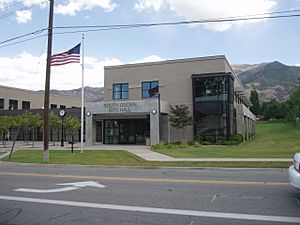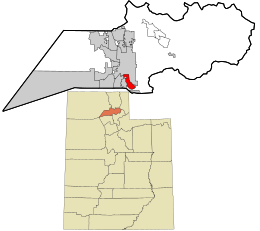South Ogden, Utah facts for kids
Quick facts for kids
South Ogden
|
|
|---|---|

City hall
|
|

Location in Weber County and the State of Utah
|
|
| Country | United States |
| State | Utah |
| County | Weber |
| Settled | 1848 |
| Incorporated | July 6, 1936 |
| Named for | Peter Skene Ogden |
| Government | |
| • Type | City Manager |
| Area | |
| • Total | 3.90 sq mi (10.10 km2) |
| • Land | 3.90 sq mi (10.10 km2) |
| • Water | 0.00 sq mi (0.00 km2) |
| Elevation | 4,675 ft (1,425 m) |
| Population
(2010)
|
|
| • Total | 16,532 |
| • Estimate
(2019)
|
17,199 |
| • Density | 4,411.13/sq mi (1,703.28/km2) |
| Time zone | UTC-7 (Mountain (MST)) |
| • Summer (DST) | UTC-6 (MDT) |
| ZIP code |
84403
|
| Area code(s) | 385, 801 |
| FIPS code | 49-70960 |
| GNIS feature ID | 2411939 |
South Ogden is a city located in Weber County, Utah, in the United States. It is part of the larger Ogden–Clearfield metropolitan area. In 2019, about 17,199 people lived there. The city's mayor is Russell L. Porter.
Contents
City Location and Size
South Ogden is a city that covers a total area of about 3.7 square miles (9.5 square kilometers). All of this area is land.
How Many People Live Here?
| Historical population | |||
|---|---|---|---|
| Census | Pop. | %± | |
| 1940 | 1,407 | — | |
| 1950 | 3,763 | 167.4% | |
| 1960 | 7,405 | 96.8% | |
| 1970 | 9,991 | 34.9% | |
| 1980 | 11,366 | 13.8% | |
| 1990 | 12,105 | 6.5% | |
| 2000 | 14,377 | 18.8% | |
| 2010 | 16,532 | 15.0% | |
| 2020 | 17,497 | 5.8% | |
| 2023 (est.) | 17,678 | 6.9% | |
| U.S. Decennial Census | |||
In 2000, there were 14,377 people living in South Ogden. These people lived in 5,193 homes. Many of these homes were families, with 3,873 families living in the city.
The city is a mix of different people and backgrounds. Many families with children live here. The average home had about 2.73 people. The average family had about 3.18 people.
The population includes people of all ages. About 27.3% of the people were under 18 years old. About 15.8% were 65 years old or older. The average age in the city was 34 years.
A Look at South Ogden's Past
Early Settlement and Naming
The area where South Ogden is now was first settled by Mormon pioneers. Daniel Burch and his family arrived in 1848. They came from Kentucky with a group led by Lorenzo Snow. In 1850, the area was named Burch Creek to honor Daniel Burch.
In 1852, the Weber Canal was built. Burch also built a gristmill, which is a mill for grinding grain, near the canal.
Growing as a Community
In 1882, the city of Ogden built a special facility in Burch Creek. This facility was for people with smallpox to help stop the spread of the disease. At this time, Burch Creek was mostly a farming area. There were many dairy farms.
Not much building happened until 1890. Then, people started investing a lot in land. They built both homes and businesses.
First Schools and Churches
The first school in the area was Burch Creek Elementary and Junior High School. It was built in 1897. People thought it was one of the most modern schools in Utah at the time. The first church building, the Ogden LDS 14th Ward, was built in 1925.
Becoming a City
By the 1930s, Burch Creek was a farming community with about 800 people. They needed more water. In 1934, a new water supply line was built. This helped a lot during a serious drought.
People often talked about making Burch Creek part of Ogden. But most people living there did not want that. Burch Creek needed better services like a sewer system, more water, roads, and sidewalks.
In 1936, a group asked the Weber County leaders to let them become an official town. Their request was approved. On July 6, 1936, the town of South Ogden was officially created.
Growth and Development
South Ogden grew a lot in the 1940s. This was because it was close to Hill Air Force Base and the Ogden Arsenal. Many new homes were built. By 1946, over 3,600 people lived there. South Ogden became known as the "City of Homes."
The biggest growth happened in the 1950s. The population grew by 150 percent! Because of this growth, a new city building was constructed. It also had a fire station, and a new fire truck was bought in 1953. Washington Boulevard, a main road, was also made wider.
Religious Communities
The Mormon pioneers settled the area, and the LDS Church is still very active. There are several LDS chapels in the city. Other churches also came to South Ogden. The Greek Orthodox Church of the Transfiguration was built in 1969. The Holy Family Catholic Church was built in 1981. There are also a few other smaller churches in the city.
A Historic Election
In 2001, South Ogden elected Utah's first African American mayor, Mayor George Garwood. He won by a large number of votes. After his election, Mayor Garwood said it was a great day. He felt it showed that people could look past someone's skin color and see their good character.
See also
 In Spanish: South Ogden para niños
In Spanish: South Ogden para niños

